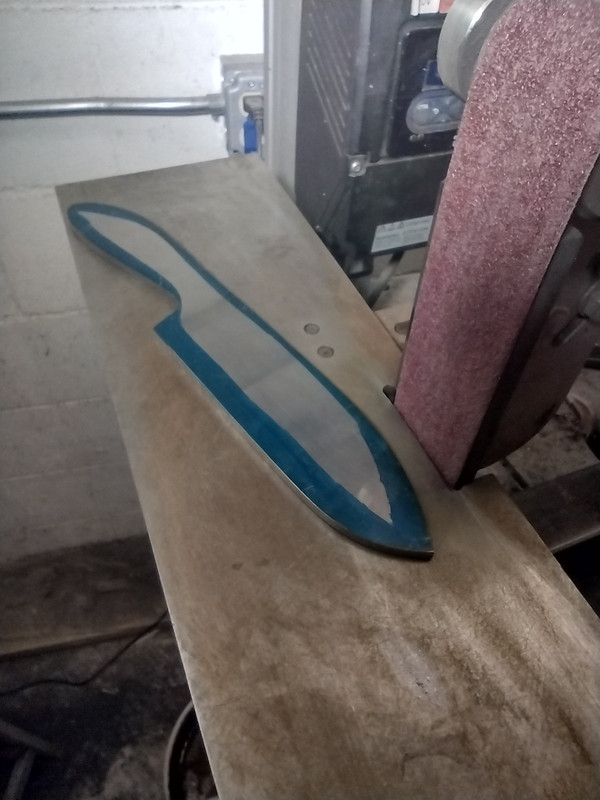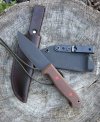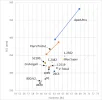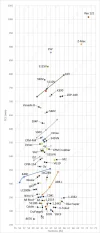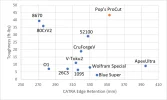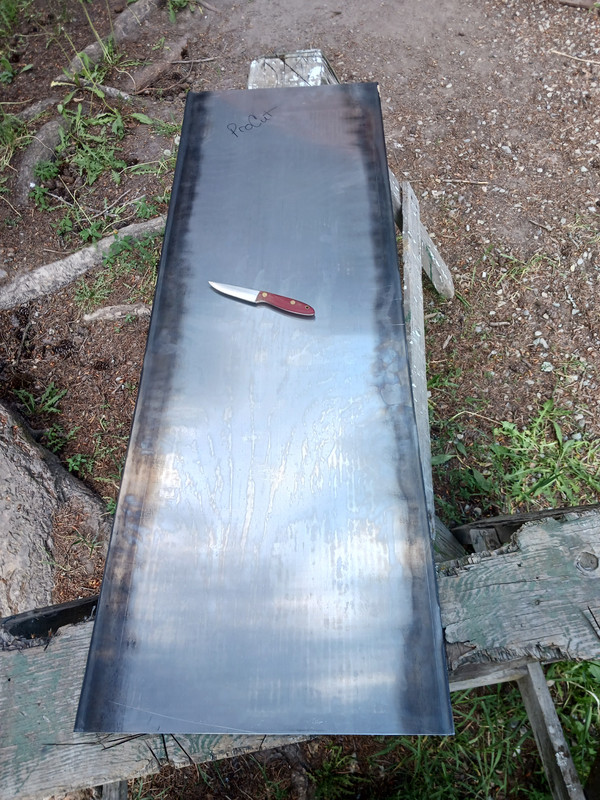You are correct Larrin. I just wanted to point out that CATRA is a way to compare steels, but other factors may effect real world useage/results/testing from others as you know. Many claim CATRA isn't accurate, but mostly because they don't really understand what CATRA is and what it is testing and how. A CATRA test sample will perform VERY differently than a regular knife in the real world! It would be interesting to see some actual knives go through CATRA testing to see how a real knife performs versus the sample pieces! I think that would really show how the other variables like geometry and edge sharpening really effect performance!
I think CATRA gives a better idea comparison wise (less variables) between steels and real world testing often shows how the steels shine in different useages. Real world grinds, thickness behind the edge and level of sharpening really effect CATRA as you know and have mentioned! AEB-L is a perfect example. Original CATRA showed so so results. The newer tests show much better results, especially at higher rockwell hardness people are now using! Plus, most people real world use isn't very abrasive, so the less alloyed steels show the benefits of a thinner edge with tougher steel and how those factors allow a "lower end" (how some feel, I really like the AEB-L style steels!!!) steel like AEB-L to perform much better than what many would think in real world use if they just looked at CATRA results, but didn't understand how CATRA tests are done and how the steel composition can effect CATRA (favors more carbide rich steels) due to the abrasion. CATRA gives us a baseline to compare how the alloys perform at a certain rockwell hardness in abrasive medium, which gives an idea of how easy the steel is to sharpen (or not) and what to expect roughly for edge retention.
I appreciate that many CATRA tests are also being done with different Rockwell Hardness, too. AEB-L at 62-63 is much better wear resistance than at 60, and the higher hardness allows for a more stable, thinner edge, which helps with overall edge retention. I made kitchen knives in 60 HRC AEB-L and also in 62 HRC AEB-L and the 62 HRC ones perform better. They will support a thinner edge with less micro chipping and seem to need less sharpening, so edge retention seems to be increased a good bit in useage with customers. The newer CATRA results with AEB-L at different hardness levels really shows this well! CATRA shows this, but maybe not the full benefits since the CATRA is an abrasive wear test and in a kitchen setting, the food is much less abrasive than the test medium is, so the thinner edge and more stable edge boosts up edge performance in a less abrasive medium and seems to contribute to longer edge retention overall. In wood working tasks, the fine, tough edge that can be taken thinner often performs better than the highly alloyed super steels, so people doing these comparisons feel the Super Steels are over hyped over the "good ole steels", but rarely think about why this is and what the steels are being designed and used for. People often see this that the "lower alloy" steels have lower CATRA numbers, but the "Super Steels" in real world use don't always outperform the "lower" steels in edge retention by as wide of a margin as CATRA would suggest. This is usually because they don't understand CATRA fully and how other variables can effect real world results. So they end up snubbing the CATRA, saying that the "super steels" don't perform as well as the lower end steels, or don't outperform them by a large margin, and feel CATRA is inaccurate and that their "real world tests" are more accurate because they don't really understand the nuances and that their knives will not perform the same as a CATRA sample if it was tested! CATRA has specialized test coupons that do not always mimic actual real using knives geometry, edge grit, etc. but many don't understand this and snub CATRA as inaccurate. I find that the lower alloyed steels actually outshine the CATRA results and perform closer to the higher end steel that many would like to think in normal useage.
Abrasive wear resistance is a key aspect to edge retention, but with many steels, especially lower carbide steels, the CATRA testing doesn't always paint the full picture. The tougher steels that can handle the thinner edges sometimes do a lot better than would be expected from the CATRA results in real world use, like food prep. With more alloyed/higher carbide steels, the wear resistance is higher in CATRA, but the steels are often less tough and may not support an edge as fine in real world use, so the carbides may not provide the increased edge retention in real world use due to micro chipping and other variables that someone would think from CATRA, especially with a less abrasive real world medium.
Knife performance is more than just the steel composition! Heat treat, geometry, sharpening angles and grits, etc all play a HUGE role in knife performance. CATRA gives a great way to compare steels evenly in specialized test pieces and with an abrasive medium, but some people take it as an end all result and don't understand it's a piece to understanding the whole puzzle, not the puzzle itself!
Let's face it. Most knife knuts use their knife to open the mail, cut down amazon boxes and light duty use, or kitchen use. Many of us aren't really pushing the envelope on edge retention or toughness and if we were given identical knives in different steels, would be VERY hard pressed to really be able to say one knife outperformed another knife in our typical useage, especially short term. We also typically like to sharpen constantly, so we aren't always really pushing the edge retention aspect, either since we often touch up to keep it stupidly sharp. Cutting down cardboard may show a difference because cardboard is abrasive, but cardboard varies a lot and the direction can effect things. Most people cut the tape on cardboard, not the cardboard itself, too. So for most of us, the differences in the steel are moot provided that the knife was properly designed and created for the tasks at hand, the heat treatment was done correctly and a decently appropriate steel was used.
But ProCut seems very impressive so far and I am itching to try it out! I like carbon steels and this one really looks like a winner, but on paper and CATRA and also real world reports so far! Well done Larrin!!

